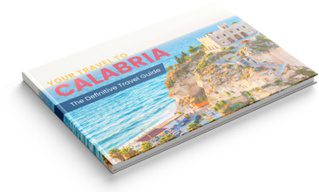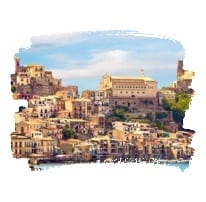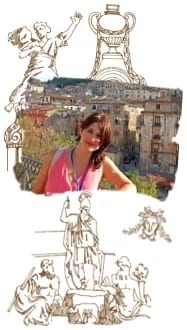Introduction
When we talk about Calabria, one of the cities that come to our mind is Stilo. That’s because it is one of the most visited villages and one of the most beautiful in the entire region. Today we are going to Stilo. It is an extraordinary village situated at the foot of Mount Consoles, dominated by the ruins of what was once a large and powerful nomad castle. Let´s go? Let’s know Stilo? Stay with us and make the best of boot country! Here at Your Travel to Calabria you make the trip of your dreams!!! Are you staying in Calabria? Looking for a hotel? Click here and discover best accommodation options in Calabria!
The town of Stilo is famous not only for being the birthplace of the famous philosopher Tommaso Campanella, but also for harboring the famous ‘Catholic’, jewel of Byzantine art and architecture, one of the most important monuments in all of Calabria and Southern Italy!
Location
Its location, embedded in the stones of one of the most beautiful and scenic landscapes of the country, a few minutes from the charming natural park of Serre, is one of the most popular destinations for all: pilgrims, visitors and tourists from around the world. LEARN MORE ABOUT STILO WATCHING THIS VIDEO!
Center of history and culture of the most representative of all of Calabria, Stilo is one of the most interesting points and its location is already something special: the old village stands imposing amidst terraces in limestone, on a slope between olive groves and vineyards. This current reality certainly places it far from its original oriental appearance of the tenth century when the city was the main Byzantine center of southern Calabria.
What to visit in the charming village of Stilo?
The town has a monumental religious architecture and beauties quite interesting to admire. The city’s highest monument is the Catholic Church, one of the best preserved and most elegant Byzantine churches among those still existant.
1) Let’s know Stilo? VISIT THE CATHOLIC
The Catholic is the first stage of a visit to Stilo. It is one of the most spectacular and fascinating churches in Calabria, an exciting Greek-Byzantine temple which construction dates back to the tenth century. The Catholic was the first and most important parish of the village of Stilo and thus remained until 1600.
The Building
As can be seen from the building, the architecture, the richness of the frescoes and the lead roofs of the domes show that it is not a temple of small importance, which inevitably is also deduced from the name ‘Catholic’ indicating the category of ‘privileged churches’ of First Instance. With the terminology used under Byzantine rule in the southern provinces of Italy (subject to the Greek rite), the definition of Katholiki belonged only to the churches with the baptistery.
Considered one of the most spectacular churches in Calabria and many other places, the Catholic Church follows the classic Byzantine style in the Greek square and cross. The building is adorned by five cylindrical domes, covered with tiles arranged in a diamond and cracked in the center by similar bricks, placed in ‘saw tooth’, that allow ‘breaking’ the coldness of the underlying cubic mass. On the inner walls of the church, you see frescoes in several layers, which witness the passage through five cycles of history.
Source: Riviera di Nausicaa
A Little more about The Catholic
The first, concerning the tenth century, the construction of the monastery contains representations of holy warriors in traditional Byzantine style. The second is from the Norman period and portrays St. John Chrysostom. The third is Swabian and describes the warning. The fourth is an international Gothic technician and represents Saint John the Baptist with other saints. And the fifth is the eternal sleep of the Virgin, which can be seen in the coat of Anjou lilies that suggests an air of romanticism. There are also catholic inscriptions in Arabic. This, in fact, is the sign of a possible use of the Catholic Muslim oratory.
2) Let’s know Stilo? VISIT THE CASTEL
Walking around the historical core of the city it is easy to recognize the signs of civilization and rulers over the centuries, including the testimony of great value and charm that is the castle, built by Ruggero, the Norman and which is at the top of the Consolino hill. It is closely linked to the development of Stilo, which was also surrounded by ramparts, towers and other bastions properly erected in defense and to have better control of the whole city, from the valley to the Ionian Sea. At that moment in history the Stilo Castle had great strategic importance. Rectangular and surrounded by defense works, today there are only the ruins of the walls, towers and gates. It was destroyed by the French during the war with Charles V, in the eighteenth century.
A little more about The Castel
In the castle, in the time of Carlos of Anjou, several political prisoners were arrested and had their hands and feet cut for trying to escape. After that it was impossible to succeed in an escape because the prisons were excavated under the castle, on the wall of Mount Consolino, where there is the mountain of limestone and sinks hanging, vertically, by hundreds of meters. That is why the prisons did not even have a door, because one could enter or leave only if placed inside or taken with a winch.
Source: Olivadoti Antonio
3) Let’s know Stilo? VISIT THE DUOMO
The ancient city of Stilo is to be applauded. It is full of palaces and churches, including the Duomo, built in 1300, the church of St. Francis, the church of St. George, the church of Our Lady of Grace and the Church of St. John Theresti. The Duomo is still today a well-preserved bulding (XIII-XIV sec.), with a remarkable gothic portal and tiny Roman and medieval bas-reliefs on its frontage.
Location
Located in the Square, but with the front door facing a narrow side street, Stilo Cathedral or Mother Church, is one of the most beautiful religious buildings in the village. Less important than the ancient Byzantine church known as the Catholic, the cathedral has a stunning beauty and is adorned by its majestic Romanesque-Gothic portal, which after the earthquake of 1783 that struck hard Calabria, was partially rebuilt.
A little more about The Duomo
Under the current building that remains on the place, signs of its original paving have been found, Byzantine adornments next to the main entrance is an unusual sculpture: two bare feet arranged vertically along the wall trying to climb it. On the left of the portal you see two feet ‘alla’ Roman style, these fragments, undoubtedly, belonging to a statue of the classical era. Inside the cathedral of the beautiful oil painting altar of the 600, Heaven or All Saints, by Giovanni Battista; Caracciolo – said Batts – rich cutlery, old vestments and various scrolls from 1600-1700, enrich the ecclesiastical patrimony of the Matrix Interesting is the crypt under the parent church.
 ALL YOU NEED TO KNOW ABOUT CALABRIA
ALL YOU NEED TO KNOW ABOUT CALABRIABuy your e-book now – “Your Travel to Calabria”
DOWNLOAD NOW!
Planning your trip to Rome? Get our e-book!
download THE E-BOOK 'YOUR TRAVEL TO ROME'
4) Let’s know Stilo? VISIT THE CHURCHES
Meet some churches in Stillo and be enchanted by their stories.
Church of St. Francis
The Church of St. Francis, however, is part of a vast and complex desire, and was founded in the Renaissance around the year 1450. In the elegant Baroque style, was decorated with many changes, and is one of the best creations of 700 in Calabria. Behind the church is an imposing bell tower that still has its medieval characteristics. The Cloister of the Convent still partially exists, in Tuscan style, with twenty arches of granite, carved by the mason Canigli, measure of San Bruno Serra. Inside the church we can admire some frescoes attributed to the painter Francesco Cozza Stilo.
St. Nicholas of Tolentino
If the Catholic works of Stilo can be considered a perfect example of the Byzantine temple in Italy, another memory left by the monks in this land is the small church of St. Nicholas of Tolentino, projected on the Stilaro valley, once used as a church, belonging to the Order Hermits of Saint Augustine. It presents a sweet dome ‘a trulli’ by the characteristic arrangement of tiles that cover it.
Church of St. John Theresti
Also of baroque style, with its interior decorated with stucco, with a beautiful frontage flanked by two towers, the Church of St. John Theresti, built in 1625 and dedicated, in 1662, by the basilian monks to the saint, whose relics are preserved. Its interior has three naves, all decorated with stucco, as the baroque art required. Worthy of admiration is the altar, in the left hallway, dedicated to the saint of Stilo that was consecrated to the Church and reproduced in a bronze bust; it is finely crafted of inlaid marble and retains its basic Theresti relics along with those of the two other saints.
The frontage of the church is beautiful, supported by two bell towers, paintings, sculptures, gold and other works of art that are patrimony of the Church and give them artistic importance certainly unique. Attached to the convent, said the Liguori, it was accessed by a marble portal. This was an idea that worked well, crowned by a harmonious wrought iron porch (1759).
Church of San Domenico or the Rosary
At the bottom of the oldest nucleus of Stilo we will find the Church of San Domenico or the Rosary, adjacent to the ruins of the Dominican convent of Santa Maria of Jesus, places related to the life of the philosopher Tommaso Campanella. The small convent of the Church of San Domenico, built around 600 Dominicans, housed the friar, Tommaso Campanella, in his younger years.
5) Let’s know Stilo? VISIT THE FONT GEBBIA
Just outside the walls of the old town, and a few meters from the place where the Royal Gate opens, we will find the Font Gebbia, commonly known by that name, but also known as the Fountain of the Dolphins. With this example, we can say that, historically, Stilo also suffered the influence of Arab art, due to the incursion of this people, especially during the Battle of 982 that saw Otto II defeated by the Byzantines for the first time. Thus, the name, which is intended to indicate the place where it was built (gebiòn, Basque campaign, outside the walls), the sculptural core is fundamental because it represents two intertwined dolphins, which are precisely the Arabic mold in its purest version.
There are also countless impressive noble palaces that multiply in the center and near Stilo. Just to name some examples: the civil constructions that belonged to the Counts Capialbi, and the various palaces that belonged to the families Carnovale, Bono, Crea, Marzano, Caracciolo, Teti, Sersale, Lamberti and many other important families.
Stilo Itinerary

A Little more the History Stillo…
Telling a little of its history, Stilo seems to be founded on the memories of an ancient colony called Magnulacre Kaulon, around the seventh century. In fact, it was considered the last fortification of the ‘polis’ in the Promontorium Cocyntum when even the modern city took the name ‘Stilida’.
The origins of Stilo
The origins of Stilo are linked to the destruction of the city of Kaulon by Dionysus of Syracuse, during the heyday of the Greek empire. From the 7th century this area became one of the main objectives of the Eastern Orthodox monks. Stilo received hermits and basilian monks who lived in the caves and built the masterpiece that is the Catholic, witness of oriental art and jewel of Byzantine architecture. STILO IS MEMBER OF ‘THE ASSOCIATION OF THE MOST BEAUTIFUL VILLAGES IN ITALY’. From the 10th century it became the most important Byzantine center of southern Calabria. Its resistance to the normands and its stubbornness loyalty to the Anjou made Stilo one of the most important castles in the region.
During the course of the Middle Ages, the inhabitants of the coast will go further into their lands, creating the medieval nuclei of the present-day towns of the Stilaro Valley; like the inhabitants of Stilida, who will at first live on Mount Consolino, very close to where today is the city of Stilo and in a second moment they created Stilo. With the Norman period, Stilo became a real place, unlike other cities like Cotrone, Catanzaro and Gerace, which became inhabited and controlled by feudal lords, a privilege they will retain until the fourteenth century when Charles V of Spain revoke all privileges. The city, among other things, is known to be the birthplace of the philosopher Tommaso Campanella, author of ‘The City of the Sun’.
LEARN MORE ABOUT STILO WATCHING THIS VIDEO!
How to get there?
1) How to get there? BY PLANE
The Airport of Reggio Calabria (150 km) or Lamezia Terme (145 km).
2) How to get there? BY TRAIN
The direct trains of the main Italian cities and with the Rome-Naples-Lamezia Terme line – Catanzaro – Monasterace – Stilo
3) How to get there? BY CAR
From the North: A3 exit Lamezia Terme – Catanzaro State – to 106 Ionian – crossroads Mar. Monasterace – State 110. From the south: A3 exit Rosarno – Ionian road Tirreno-Marina di Gioiosa Jonica – the 106 – Stilo junction.
Traveling in Italy by car?
Don’t know where to rent the car? We have a partner who can help: Rent Cars! Have you ever thought about renting a car in Italy, leaving home, with English service, paying in Real, without IOF charges and still being able to pay in installments in 12x without interest on the card? How about a 5% discount for cash payment? Like the idea? Then click on the banner below Search, compare and choose! 🙂
Lets go to know our Calabria?
Watch this video: Discovering Calabria with Ana Patricia: tour in Cosenza
Subscribe to our channel and receive more videos with information and tips about Italy. Don’t forget to leave that Like;)
Conclusion
Let’s know Stilo? Stilo is one of the art cities of Calabria, beautiful and interesting, as a borough to our ‘Byzantine Island’. It is the city of the famous philosopher Tommaso Campanella, and has the jewel of Byzantine art that is Catholic, a masterpiece of southern Calabria. It is also one of the routes that should never stop being seen. It is a village to visit, which is fascinating by its geographical location and its territory, where there is a great number of ‘laure’ of Eastern monasticism.
The Greek culture transplanted in Calabria was mainly the work of the Byzantine monks who preferred to live and, on several occasions, to build rural churches in the most inaccessible areas. Having chosen, among others, Stilo, they immediately went in search of natural caves, inspecting the entire eastern wall of Mount Consoles. They dedicated their life to total solitude, fully respecting the rules chosen by Father Basilio and probably, in Stilo, you will be able to feel the peace that has been left by these monks throughout history.
A Little more of the Beauties of Calabria
TRAVELING TO CALABRIA IS A WONDERFUL EXPERIENCE, BUT BEING A REGION WITH A SMALL TOURISM INFRASTRUCTURE FOR FOREIGNERS, IT IS NOT SO SIMPLE TO VISIT THIS AMAZING PLACE WITHOUT ANY HELP, ESPECIALLY IF YOU DON’T SPEAK ITALIAN.
HIRING OUR SERVICES YOU WILL BE ABLE TO ADMIRE EVERYTHING THAT THIS BEAUTIFUL AND SPETACULAR REGION HAS TO OFFER!
ENJOY EVERY SINGLE MOMENT BY HIRING THE SERVICES OF A PROFESSIONAL THAT CAN GIVE YOU THE GUARANTEE OF THE BEST SERVICE.
WHY EXPERIENCE STRESSFUL TIMES ON YOUR SO DREAM VACATION IF YOU CAN HAVE EXCELLENCE IN SERVICE FOR THE BEST COST – BENEFIT?
TO LEARN MORE ABOUT OUR RATES, ‘MY GUIDE’ SERVICES, TOURIST ESCORTING, INTERPRETER OR ASSISTANCE TO FIND THE DOCUMENTS OF YOUR RELATIVES CALABRESES, EMAIL ME!
SEARCH, COMPARE AND CHOOSE! YOU WILL NOT REGRET!
I AM A GUIDE WITH EXPERTISE IN PORTUGUESE AND ENGLISH LANGUAGE IN CALABRIA, AND I AM SURE YOU WILL LOVE TO SEE THIS AMAZING ITALIAN REGION WITH ME! IT WILL BE AN UNFORGETTABLE JOURNEY!
I’M WAITING FOR YOU! 🙂
* FOR TOURISTIC SERVICES IN OTHER LANGUAGES, PLEASE SEND AN EMAIL.
An Extra Help for your Trip
The best content from Viajando para a Itália!
Learn more about our tours in Calabria right now!
- Itinerary for 3 days in Calabria?
- Itinerary for 6 days in Calabria?
- Learning To Cook In Calabria? Itinerary in 7 days: the best!
- What are the 10 places you need to go in Calabria?
- Why should you visit Tropea in Calabria?
- All about Reggio.
- All about Cosenza.
- What is the best time of the year to go to Calabria?
- How to get from Lamezia Terme airport to downtown of Lamezia, Cosenza and Reggio Calabria?
- Where to stay in Calabria?
Check all our posts about Calábria!
Best regards from Calábria



 AIRPORTS IN CALÁBRIA
AIRPORTS IN CALÁBRIA 30 MINUTES OF TRAVEL ADVICE FOR FREE!
30 MINUTES OF TRAVEL ADVICE FOR FREE!

 By hiring my services, you save money and time, and still travel with great peace of mind!
By hiring my services, you save money and time, and still travel with great peace of mind!